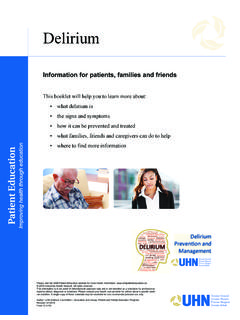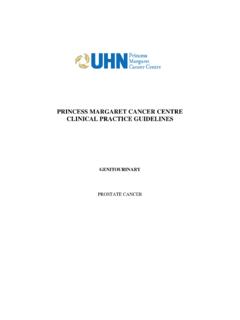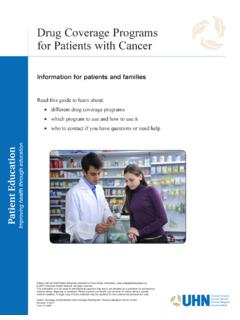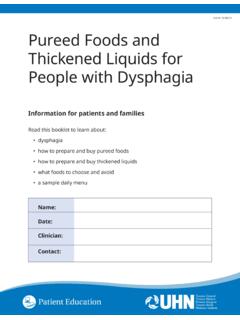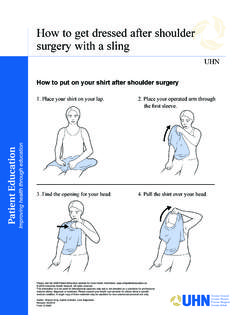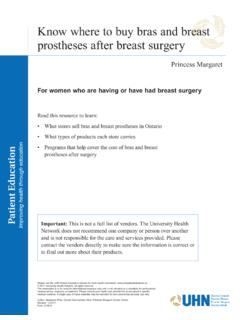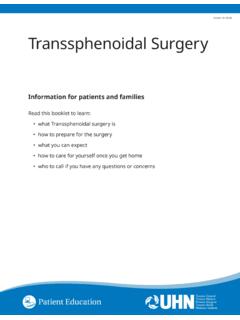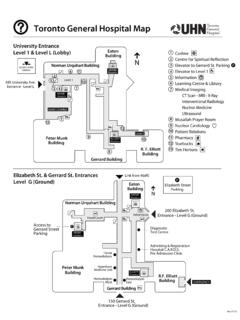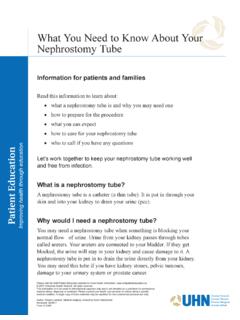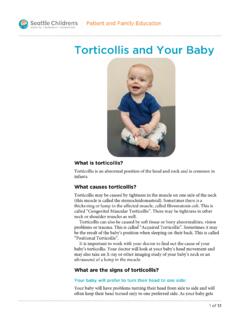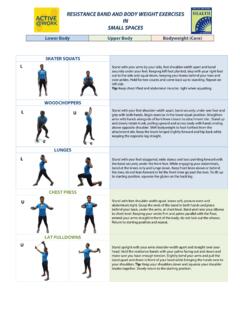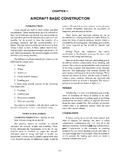Transcription of How to Do Self Lymphatic Massage on Your Upper Body
1 Form: D-5804. How to Do self Lymphatic Massage on Your Upper body For patients who were treated for cancer on one side of their Upper body that included any of the following: For example: Surgery that removed lymph nodes in your underarm Radiation to lymph nodes in your underarm Radiation to an area of your Upper body where lymph nodes were removed This pamphlet explains: What self Lymphatic Massage is and why it is important How to do self Lymphatic Massage step-by-step Disclaimer: This pamphlet does not replace manual lymph drainage Massage performed by a trained Combined Decongestive Therapist in your community. It is meant to be used as a guide to help patients with lymphedema and/or their family members do self - Lymphatic Massage after they have been taught these skills by a Combined Decongestive Therapist. What is the Lymphatic system? The Lymphatic system is made up of lymph nodes, lymph vessels and lymphoid organs (such as the tonsils, spleen, etc.). The picture below shows the lymph vessels and lymph nodes in different areas in your body .
2 The circles show the clusters (groups) of lymph nodes that are commonly removed or radiated during some cancer treatment. Our Lymphatic system collects and filters fluid from all the tissue in our body . In the lymph nodes waste products are removed or broken down into smaller parts. The lymph fluid returns to the circulatory system (heart, veins and arteries). just before the blood enters the heart. If the pathways the lymph travels through are blocked/compromised, fluid and proteins can build up in your tissues. The Lymphatic System Circles show where clusters (groups) of lymph nodes are in your body that are commonly removed during cancer treatment. How does self - Massage help with lymphedema? Manual Lymph Drainage, or Lymphatic Massage gently stretches the skin and helps move fluid away from an area that is swollen to areas of the body where the Lymphatic system has not been affected by cancer treatment. Lymphatic Massage is very different from deep muscle Massage . This Massage uses light pressure and gentle, rhythmic strokes to help increase the flow of lymph.
3 2. This Massage helps to move fluid away from areas of your body that may be swollen or damaged due to cancer treatment. If you had surgery and/or radiation to the lymph nodes in your underarm, the areas that you will move fluid (swelling) AWAY from are your: affected arm trunk chest affected breast The extra fluid can be moved TO your: unaffected underarm neck groin Instructions for doing self - Massage Use a light pressure and keep your hands soft and relaxed. Use just enough pressure to gently stretch the skin as far as it naturally goes and then release the pressure and let your skin come back as it was. If you can feel your muscles underneath your fingers, then you are pressing too hard. Use the flats of your hands instead of your finger tips. This allows more contact with the skin to stimulate the lymph vessels. Massage towards areas of your body that have not been treated for cancer. Make sure you are comfortable. You may want to support the arm on the side that was treated for cancer on a table or with pillows, so your shoulder and arm can relax.
4 self - Massage can be done while seated, standing or lying down. Choose the position that is most comfortable for you. Try to put self - Massage into your life (as you do with other self -care activities) in a way that works for you. What to avoid Do not strain your shoulders, neck, arm or hand Do not self - Massage in a way that causes pain Do not continue self - Massage if it is causing you pain Do not do self - Massage if you have an infection in that area If you have a port-a-cath, avoid bumping it while doing self - Massage 3. Important: DO NOT do self Massage if you have an infection in your breast(s), chest or arm(s). Signs of an infection may include: Swelling in these areas and redness of the skin (this redness can quickly spread). Feeling pain in one or both breasts, chest or arms Feeling tenderness and/or warmth in one or both breasts, chest or arms Having a fever or chills and feeling unwell If you have an infection or think you have an infection, go to: Your Family Doctor Walk-in Clinic Urgent Care Clinic Emergency Department Try different ways to make self - Massage a part of your routine.
5 Some people prefer to do self - Massage while they are watching TV or having a shower so that it does not take time away from their day. Other people prefer to use self Massage as time for themselves or as part of their relaxation routine. Steps 1 4 stimulate your lymph system 1. Deep Breathing A very important part of your self -care is deep breathing. Deep breathing helps to stimulate Lymphatic system in your whole body . You can practice deep breathing anytime! Place the palms or flats of your hands on your stomach Slowly, breathe in deeply through your nose, and let your stomach expand Breathe out slowly through pursed lips (as if you were about to blow out a candle), and let your stomach flatten Repeat 5 times. Take a short rest between each breath so you do not get dizzy 4. 2. Stretch and release the skin at the front of your neck This step helps lymph fluid drain back to your heart. You can Massage one side at a time, or do both sides together by crossing your hands. Place the flats of your 2nd and 3rd fingers on either side of your neck, just above your collarbone.
6 Massage down and inwards towards your collarbone. Always keep your fingers above your collarbone. Gently stretch the skin just as far as it naturally goes and release. This Massage will look like two J strokes facing one another. Repeat 15 times. 3. Stretch and release the skin at the side of your neck You can Massage one side at a time, or do both sides together. Place your flat hands on either side of your neck, just under your ears. Gently stretch the skin back (away from your face). and down, then release. Try to Massage your neck in a slow, gentle way, following a rhythm. Repeat 10 to 15 times. Remember: Keep your pressure light and your hands soft and relaxed. 4. Stretch and release the skin on the back of your neck Place your flat hands on the back of your neck, just below your hairline on either side of your spine. Stretch the skin towards your spine and then down towards the base of your neck and release. Repeat 10 to 15 times. 5. Steps 5 11 will help to address symptoms of lymphedema that you may be experiencing 5.
7 Prepare your chest This step prepares the lymph nodes in your under arm to take in lymph fluid from the affected side of your chest (the side you were treated for cancer). For the following chest Massage , place the arm on the side of your body that was not treated for cancer in a comfortable position slightly elevated and supported, if that feels comfortable for you. Place your palm against your underarm on the side that was not treated for cancer. Gently pull up and in toward your body , then release. Repeat 10 to 15 times. 6. Massage your scar You may begin scar Massage three weeks after surgery and after all staples and clips have been removed. Your scar may feel very sensitive, tight or itchy. Scar Massage will help reduce these feelings and soften the scar and allow better circulation in the area. Scar Massage should always be pain free. Move up and down in a zigzag pattern or circular pattern along your scar. Apply firm but gentle pressure while moving along the scar. If possible, gently lift the skin along the scar.
8 Repeat 5 or 6 times on your scar(s). Tip: You can do scar Massage anytime that your scar feels tight or stuck to your chest wall. 6. 7. Stretch and release the skin from your Upper chest to your neck This step will move fluid up to your neck. Try to find a position that is most comfortable for you and does not strain your wrist. If you have had a mastectomy: Place your hand above your scar. Massage up your chest to your neck, gently stretch the skin as far as it naturally goes and release. Repeat 10 to 15 times. If you have had a lumpectomy: Place your hand on your chest above your breast. Massage up your chest to your neck, using several small strokes. Gently stretch the skin as far as it naturally goes and release. Repeat 10 to 15 times. 8. Prepare your chest This step will move fluid away from the side of you body that was treated for cancer. Try to find a position that is most comfortable for you and does not strain your wrist. Place your hand by your underarm on the side of your body that was treated for cancer, above any scar.
9 Gently Massage across your chest using several small strokes. Start on close to your underarm on the side of your body that was treated for cancer and Massage across your chest over to the other underarm. Gently stretch the skin as far as it naturally goes and release. Repeat 10 to 15 times. 7. 9. Prepare your groin area This step will prepare your groin to receive fluid. Do this step on the side of your body that was treated for cancer. Place the flats of your hands over the crease at the top of your leg (as if you were putting your hand in your pocket). Gently press in towards your body (arrow 1) and then roll up as shown in (arrow 2). Your hand will stay in one spot. Repeat 15 times. 10. Stretch and release the skin from your Upper arm to your groin This step will direct fluid from your Upper arm, down the side of your body to your groin. If you are having trouble raising your arm, try placing it on a table for more comfort. Do this step on the side of your body that was treated for cancer.
10 Start at the inner part of you Upper arm. Massage around to the side of your chest down towards your groin. Gently stretch the skin as far as it naturally goes and release. Repeat 15 times. 11. Stretch and release the skin from your chest to your groin This step will direct fluid away from your chest to your groin. Do this step on the side of your body that was treated for cancer. Place your hand on your chest below any scar. Gently stretch and release the skin moving down the side of your body to your groin area. Repeat 10 to 15 times. 8. 12. Stretch and release the skin on your Upper arm This step will direct fluid from the inside of your arm to the back or outside of your Upper arm and into your neck. Shoulder Start at your shoulder and gently stretch and release the skin, moving over your shoulder toward your neck. If it does not strain your wrist, you can also Massage across the back of your shoulder to your neck. Repeat 15 times. Inside your arm Stretch and release the skin from the inside of your arm to the top of your Upper arm.
